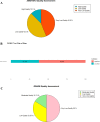Unveiling the efficacy of repetitive transcranial magnetic stimulation in Parkinson's disease: A comprehensive review of systematic analyses
- PMID: 39761282
- PMCID: PMC11703078
- DOI: 10.1371/journal.pone.0313420
Unveiling the efficacy of repetitive transcranial magnetic stimulation in Parkinson's disease: A comprehensive review of systematic analyses
Abstract
Background: Many systematic reviews (SRs) have reported the repetitive transcranial magnetic stimulation (rTMS) for Parkinson' s disease (PD), but the quality of the evidence is unclear. The aim of this study was to summarize the evidence provided by SRs on the effect of rTMS on PD.
Methods: A comprehensive search for SRs published from the establishment of the library to March 1, 2024, was conducted in PubMed, EMBASE, Cochrane Library, Web of Science, CNKI, VIP and Wanfang databases. The A Measurement Tool to Assess Systematic Reviews 2 (AMSTAR-2), the Risk of Bias for Systematic Reviews (ROBIS), and Grading of Recommendations, Assessment, Development, and Evaluation (GRADE) tool were used to evaluate the methodology quality, risk of bias and evidence quality of SRs, respectively.
Results: We identified 16 SRs. According to the results of the AMSTAR-2, 12.5% (2/16) of the SRs rated as high quality, 43.75% (7/16) rated as low quality, and 43.75% (7/16) rated as very low quality. Based on the ROBIS tool, 6 (37.5%) SRs had low risk of bias. The GRADE results suggested that 16.13% (10/62) of the evidence was of moderate quality, 33.87% (21/62) of the evidence was of low quality and 50% (31/62) of the evidence was of very low quality. Moderate-quality results show that rTMS can improve PD motor symptoms.
Conclusions: Here we show that rTMS can improve the motor symptoms of PD, but its effectiveness in treating non-motor symptoms of PD is inconsistent. Due to the methodological limitations and diversity in study designs, future studies should focus on addressing these issues by providing thorough methodological details, standardizing rTMS protocols, evaluating side effects, and comparing with other treatments.
Copyright: © 2025 Zhang et al. This is an open access article distributed under the terms of the Creative Commons Attribution License, which permits unrestricted use, distribution, and reproduction in any medium, provided the original author and source are credited.
Conflict of interest statement
The authors have declared that no competing interests exist.
Figures
Similar articles
-
Repetitive transcranial magnetic stimulation for Alzheimer's disease: an overview of systematic reviews and meta-analysis.Front Aging Neurosci. 2024 Mar 20;16:1383278. doi: 10.3389/fnagi.2024.1383278. eCollection 2024. Front Aging Neurosci. 2024. PMID: 38572153 Free PMC article.
-
Repetitive transcranial magnetic stimulation as a therapy for post-stroke dysphagia: An overview of systematic reviews and meta-analysis.Clin Rehabil. 2024 Oct;38(10):1289-1305. doi: 10.1177/02692155241264757. Epub 2024 Jul 25. Clin Rehabil. 2024. PMID: 39053022 Review.
-
Evidence Mapping Based on Systematic Reviews of Repetitive Transcranial Magnetic Stimulation on the Motor Cortex for Neuropathic Pain.Front Hum Neurosci. 2022 Feb 16;15:743846. doi: 10.3389/fnhum.2021.743846. eCollection 2021. Front Hum Neurosci. 2022. PMID: 35250506 Free PMC article.
-
An overview of systematic reviews of acupuncture for neurodegenerative disease.Asian J Psychiatr. 2024 Jan;91:103882. doi: 10.1016/j.ajp.2023.103882. Epub 2023 Dec 21. Asian J Psychiatr. 2024. PMID: 38150809 Review.
-
Tai Chi for improving balance and reducing falls: An overview of 14 systematic reviews.Ann Phys Rehabil Med. 2020 Nov;63(6):505-517. doi: 10.1016/j.rehab.2019.12.008. Epub 2020 Jan 22. Ann Phys Rehabil Med. 2020. PMID: 31981834
References
Publication types
MeSH terms
LinkOut - more resources
Full Text Sources
Medical



